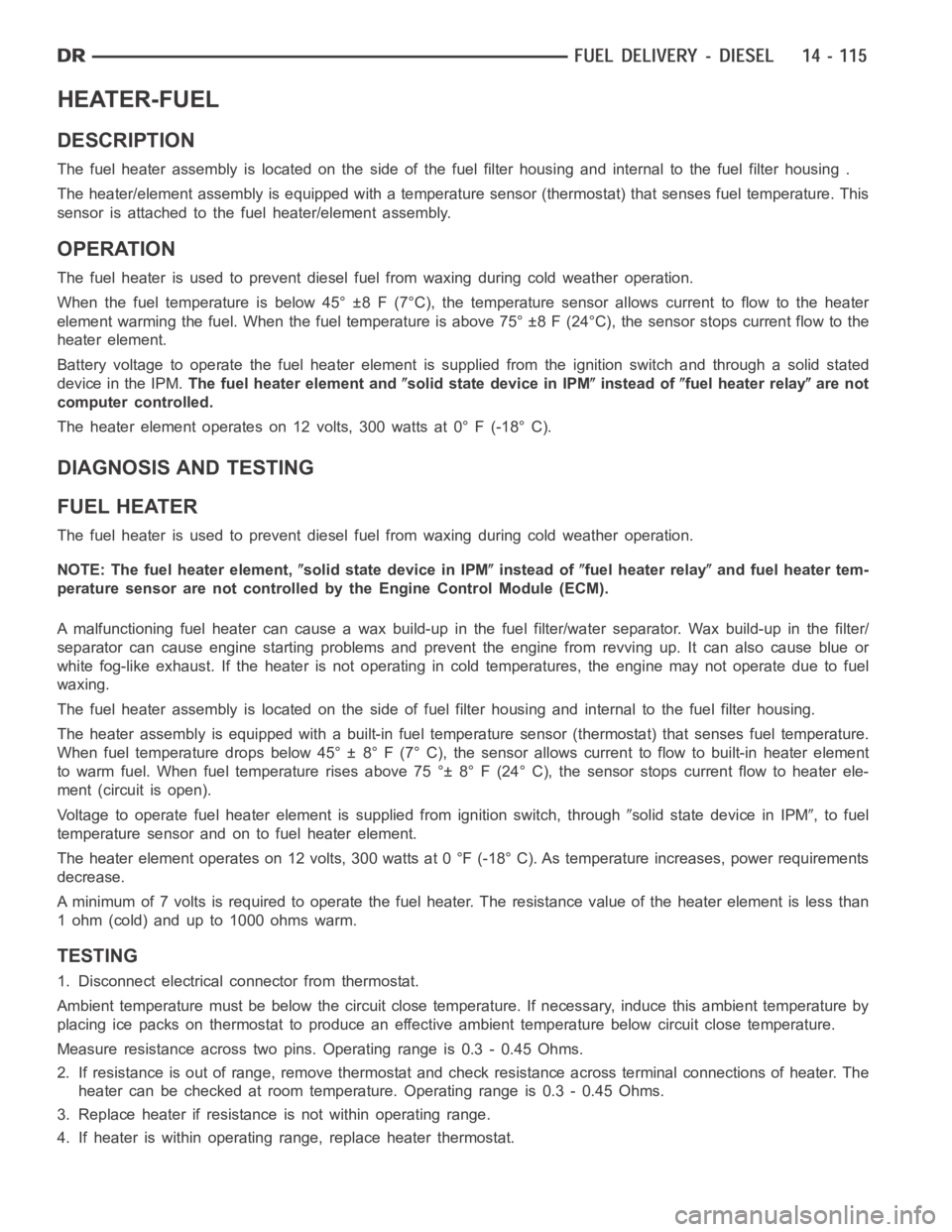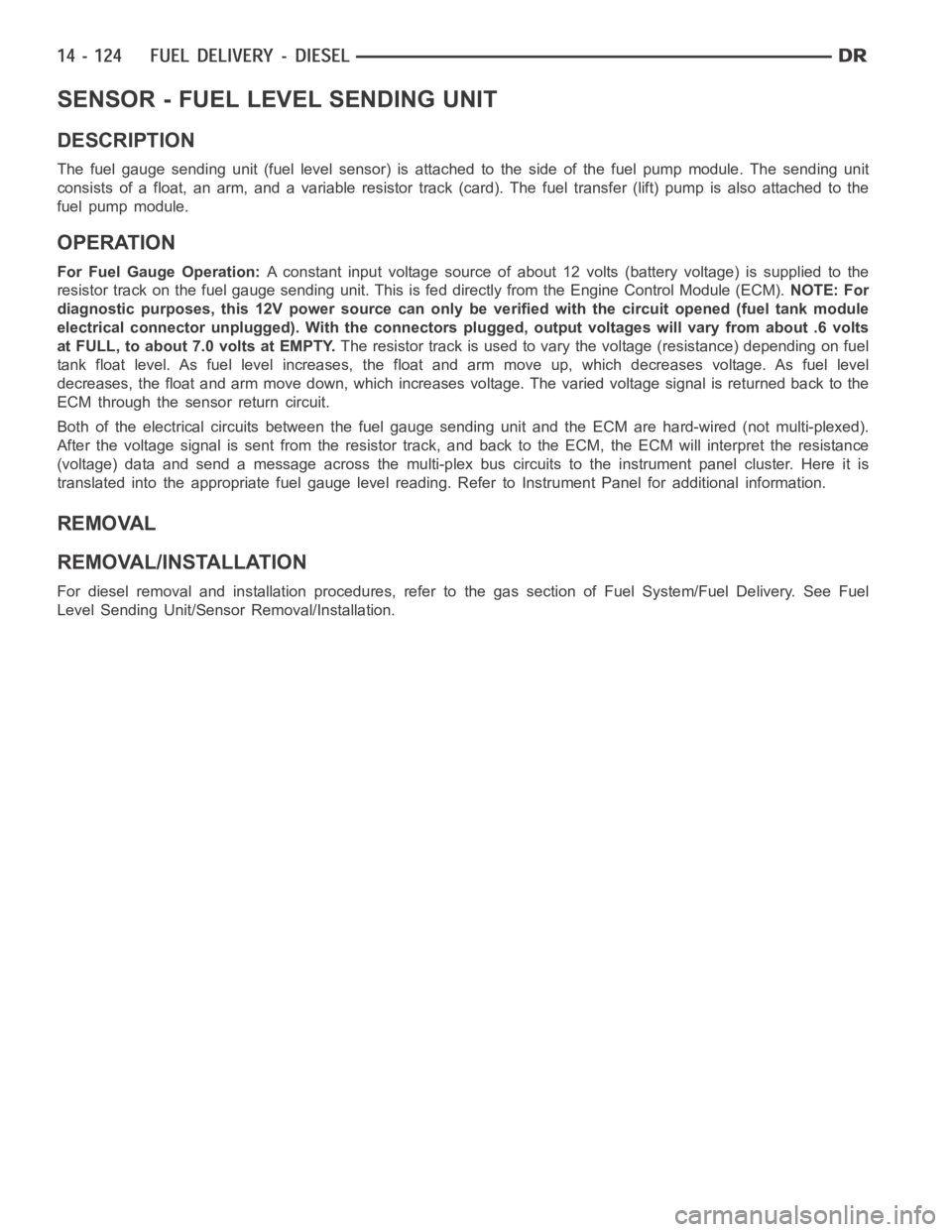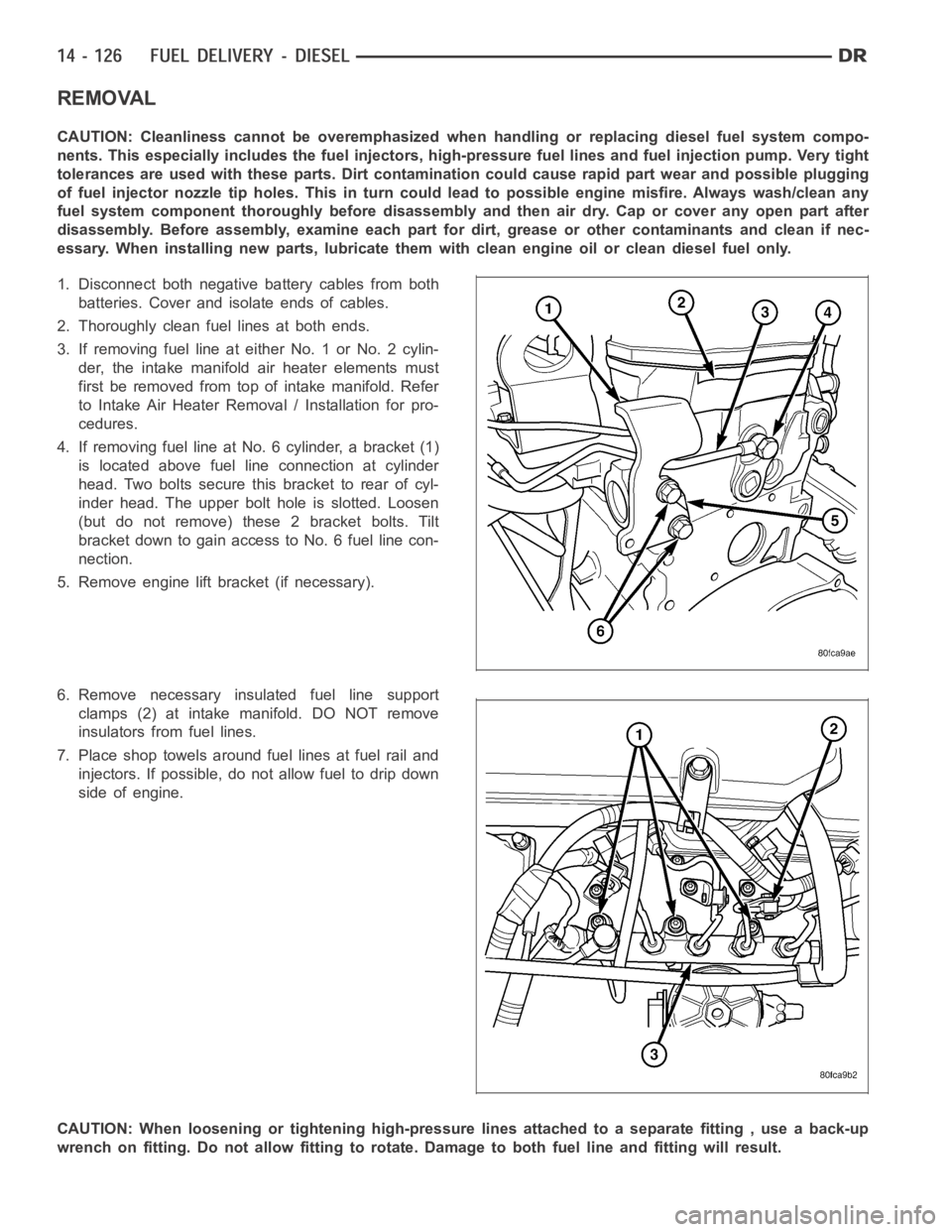Page 2327 of 5267
8.3L - SRT-10
1. Remove the throttle cable.
2. Remove the battery cover and disconnect the neg-
ative battery cable.
3. Remove the air cleaner assembly, refer to the
Engine/Air Intake System/Air Cleaner Housing for
more information.
4. Disconnect the TPS electrical connector.
Page 2331 of 5267
4. Install 4 mounting bolts. (Refer to 14 - FUEL SYS-
TEM/FUEL DELIVERY - SPECIFICATIONS)
5. Install electrical connector.
6. Install air plenum.
7.If the throttle body has been changed, the fol-
lowing procedure must be performed:
a. Disconnect negative battery cable from battery.
Leave cable disconnected for approximately 90
seconds.
b. Reconnect cable to battery.
c. Turn ignition switch ON, but do not crank
engine.
d. Leave ignition switch ON for a minimum of 10
seconds. This will allow PCM to learn throttle
body electrical parameters.
8.3L - SRT-10
1. Mount throttle body and wiring clips , tighten bolts to 12 N.m (105 in. lbs.).
2. Connect electrical connector to throttle position sensor.
3. Install the throttle cable.
4. Install the air cleaner housing, refer to Engine/Air Intake System/AirCleaner Housing.
5. Connect the negative battery cable and install the battery cover.
Page 2352 of 5267

HEATER-FUEL
DESCRIPTION
The fuel heater assembly is located on the side of the fuel filter housing and internal to the fuel filter housing .
The heater/element assembly is equipped with a temperature sensor (thermostat) that senses fuel temperature. This
sensor is attached to the fuel heater/element assembly.
OPERATION
The fuel heater is used to prevent diesel fuel from waxing during cold weather operation.
When the fuel temperature is below 45° ±8 F (7°C), the temperature sensor allows current to flow to the heater
element warming the fuel. When the fuel temperature is above 75° ±8 F (24°C), the sensor stops current flow to the
heater element.
Battery voltage to operate the fuel heater element is supplied from the ignition switch and through a solid stated
device in the IPM.The fuel heater element and
solid state device in IPMinstead offuel heater relayare not
computer controlled.
The heater element operates on 12 volts, 300 watts at 0° F (-18° C).
DIAGNOSIS AND TESTING
FUEL HEATER
The fuel heater is used to prevent diesel fuel from waxing during cold weather operation.
NOTE: The fuel heater element,
solid state device in IPMinstead offuel heater relayand fuel heater tem-
perature sensor are not controlled by the Engine Control Module (ECM).
A malfunctioning fuel heater can cause a wax build-up in the fuel filter/water separator. Wax build-up in the filter/
separator can cause engine starting problems and prevent the engine from revving up. It can also cause blue or
white fog-like exhaust. If the heater is not operating in cold temperatures, the engine may not operate due to fuel
waxing.
The fuel heater assembly is located on the side of fuel filter housing and internal to the fuel filter housing.
The heater assembly is equipped with a built-in fuel temperature sensor (thermostat) that senses fuel temperature.
When fuel temperature drops below 45° ± 8° F (7° C), the sensor allows current to flow to built-in heater element
to warm fuel. When fuel temperature rises above 75 °± 8° F (24° C), the sensorstops current flow to heater ele-
ment (circuit is open).
Voltage to operate fuel heater element is supplied from ignition switch, through
solid state device in IPM,tofuel
temperature sensor and on to fuel heater element.
The heater element operates on 12 volts, 300 watts at 0 °F (-18° C). As temperature increases, power requirements
decrease.
A minimum of 7 volts is required to operate the fuel heater. The resistance value of the heater element is less than
1 ohm (cold) and up to 1000 ohms warm.
TESTING
1. Disconnect electrical connector from thermostat.
Ambient temperature must be below the circuit close temperature. If necessary, induce this ambient temperature by
placing ice packs on thermostat to produce an effective ambient temperature below circuit close temperature.
Measure resistance across two pins. Operating range is 0.3 - 0.45 Ohms.
2. If resistance is out of range, remove thermostat and check resistance across terminal connections of heater. The
heater can be checked at room temperature. Operating range is 0.3 - 0.45 Ohms.
3. Replace heater if resistance is not within operating range.
4. If heater is within operating range, replace heater thermostat.
Page 2355 of 5267
1. Disconnect both negative battery cables at both
batteries. Cover and isolate ends of both cables.
2. Remove intake manifold air intake tube (above
injection pump) and its rubber connector hose (2).
3. Remove accessory drive belt.
4. Thoroughly clean the rear of injection pump, and
attachment points for its 3 fuel lines. Also clean the
opposite ends of these same 3 lines at their attach-
ment points.
Page 2360 of 5267
13. Connect Fuel Control Actuator (FCA) electrical
connector (3) to rear of injection pump.
14. Install intake manifold air intake tube (above injec-
tion pump). Tighten clamps.
15. Install accessory drive belt.
16. Connect both negative battery cables to both bat-
teries.
17. Check system for fuel or engine oil leaks.
Page 2361 of 5267

SENSOR - FUEL LEVEL SENDING UNIT
DESCRIPTION
The fuel gauge sending unit (fuel level sensor) is attached to the side of the fuel pump module. The sending unit
consists of a float, an arm, and a variable resistor track (card). The fuel transfer (lift) pump is also attached to the
fuel pump module.
OPERATION
For Fuel Gauge Operation:A constant input voltage source of about 12 volts (battery voltage) is supplied to the
resistor track on the fuel gauge sending unit. This is fed directly from theEngine Control Module (ECM).NOTE: For
diagnostic purposes, this 12V power source can only be verified with the circuit opened (fuel tank module
electrical connector unplugged). With the connectors plugged, output voltages will vary from about .6 volts
at FULL, to about 7.0 volts at EMPTY.The resistor track is used to vary the voltage (resistance) depending on fuel
tank float level. As fuel level increases, the float and arm move up, which decreases voltage. As fuel level
decreases, the float and arm move down, which increases voltage. The varied voltage signal is returned back to the
ECM through the sensor return circuit.
Both of the electrical circuits between the fuel gauge sending unit and theECM are hard-wired (not multi-plexed).
After the voltage signal is sent from the resistor track, and back to the ECM, the ECM will interpret the resistance
(voltage) data and send a message across the multi-plex bus circuits to theinstrument panel cluster. Here it is
translated into the appropriate fuel gauge level reading. Refer to Instrument Panel for additional information.
REMOVAL
REMOVAL/INSTALLATION
For diesel removal and installation procedures, refer to the gas section of Fuel System/Fuel Delivery. See Fuel
Level Sending Unit/Sensor Removal/Installation.
Page 2363 of 5267

REMOVAL
CAUTION: Cleanliness cannot be overemphasized when handling or replacingdieselfuelsystemcompo-
nents. This especially includes the fuel injectors, high-pressure fuel lines and fuel injection pump. Very tight
tolerances are used with these parts. Dirt contamination could cause rapid part wear and possible plugging
of fuel injector nozzle tip holes. This in turn could lead to possible engine misfire. Always wash/clean any
fuel system component thoroughly before disassembly and then air dry. Capor cover any open part after
disassembly. Before assembly, examine each part for dirt, grease or othercontaminants and clean if nec-
essary. When installing new parts, lubricate them with clean engine oil orclean diesel fuel only.
1. Disconnect both negative battery cables from both
batteries. Cover and isolate ends of cables.
2. Thoroughly clean fuel lines at both ends.
3. If removing fuel line at either No. 1 or No. 2 cylin-
der, the intake manifold air heater elements must
first be removed from top of intake manifold. Refer
to Intake Air Heater Removal / Installation for pro-
cedures.
4. If removing fuel line at No. 6 cylinder, a bracket (1)
is located above fuel line connection at cylinder
head. Two bolts secure this bracket to rear of cyl-
inder head. The upper bolt hole is slotted. Loosen
(but do not remove) these 2 bracket bolts. Tilt
bracket down to gain access to No. 6 fuel line con-
nection.
5. Remove engine lift bracket (if necessary).
6. Remove necessary insulated fuel line support
clamps (2) at intake manifold. DO NOT remove
insulators from fuel lines.
7. Place shop towels around fuel lines at fuel rail and
injectors. If possible, do not allow fuel to drip down
side of engine.
CAUTION: When loosening or tightening high-pressure lines attached to a separate fitting , use a back-up
wrench on fitting. Do not allow fitting to rotate. Damage to both fuel line and fitting will result.
Page 2365 of 5267
5. Install engine lifting bracket (1) and bolt. Torque nut
to 77 Nꞏm (56 ft. lbs.).
6. Tighten fuel lines at fuel rail. Torque nut to 37 Nꞏm
(27 ft. lbs.).
7. Tighten clamp support to intake manifold cover.
Torque nut to 24 Nꞏm (18 ft. lbs.).
8. If fuel line at either No. 1 or No. 2 cylinder has
been replaced, install intake manifold air heater
elements to top of intake manifold. Refer to Intake
Air Heater Removal / Installation for procedures.
9. If fuel line at No. 6 cylinder has been replaced, tilt
metal bracket (shield) upward and tighten 2 bolts at
rear of cylinder head. Torque nut to 43Nꞏm (32 ft.
lbs.).
10. Connect both negative battery cables to both bat-
teries.
11. Prime fuel system. Refer to Fuel System Priming.
12. Check lines/fittings for leaks.